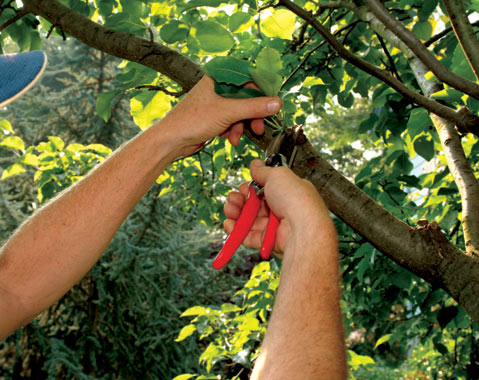Winter Pruning
Cut Back Fruit Trees to Ensure Bigger, Better Fruit Next Year

Summer sometimes has a way of lingering along the South Coast; however, winter does eventually arrive, and most of our stone (peaches, plums, nectarines, etc.) and pome fruits (apples and pears) are finally losing their leaves. Now is the time to cut them back to ensure bigger and better fruit next year. Since these types of trees bloom (and thus fruit) on wood that is one to three years old, the goal is to produce a balanced ratio of twigs and branches of all ages. Selective pruning can help to increase air circulation within the tree that will help reduce fungal diseases later in the season. Lowering the height of the tree can also be done to make picking of the fruit easier.
For deciduous flowering shrubs that bloom on new wood, pruning is done in the winter months, too. The most conspicuous examples, of course, are the many varieties of roses. Each particular type requires a slightly different approach, but the goals remain the same: to remove branches that cross or interfere with each other, reduce the amount of oldest wood, and encourage new canes that will bear flowers next year.
The amount of wood you remove from a tree or shrub will vary from species to species, but the placement of your cuts will always be the same. All cuts should be just above another point of growth, either a bud or another branch, and do not leave a stub protruding beyond the bud. Cuts should also be made at an angle of about 45 degrees, never perpendicular to the direction of growth. The result of these cuts is a profusion of new branches from the bud or buds below the cut either on the same branch or the one directly below it. This occurs because the growing tip has been producing a plant growth hormone that retards the growth of lower buds. When it is removed, these buds are released from their dormancy.
Besides the rule of never leaving a stub, the next rule of pruning is to use sharp tools, either hook-and-blade shears or pruning saws. Sharp tools will leave clean cuts that heal faster and better with less possibility of insect or disease entry through the cut surface. Most experts now agree that painting these cut surfaces with a sealer is not necessary and in fact may retard the growth of necessary callus.
So head out into the garden and make a start toward a better blooming season next spring and heftier fruit production come summer. Don’t hurry, though; there are still a couple of months to complete the chore.
Winter Tips
• Bring your living Christmas tree in for 10 days or less and keep away from heaters and fireplaces.
• Light pruning of evergreens can add holiday cheer without harming the parent plant. Cut close to the larger branch with sharp pruning tools.
• You can still plant winter vegetables: cabbage, chard, beets, carrots, radishes, and spinach.
• Winter is the time to prune trees that are susceptible to beetle damage such as pines and eucalyptus. Cover the wood tightly to keep beetles from escaping or chip the wood as you prune.



